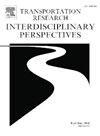交通导向建筑环境对COVID-19传播的抵御力:来自武汉市主要城市社区的证据
IF 3.9
Q2 TRANSPORTATION
Transportation Research Interdisciplinary Perspectives
Pub Date : 2025-05-01
DOI:10.1016/j.trip.2025.101448
引用次数: 0
摘要
在2019冠状病毒病引发的全球卫生危机中,管理感染传播成为城市地区面临的巨大挑战,特别是在人口密集地区,这凸显了韧性规划方面的严重不足。本研究探讨了武汉市以交通为导向的发展导向(TOD-guided)社区内的建筑环境特征对COVID-19传播模式的影响。通过构建一个新的分析框架,将TOD原则与建筑环境因素相结合,我们研究了这些因素如何影响流行病在不同城市和周边社区的传播。利用空间和空间统计技术的结合,我们评估了人口密度、公交车站密度、公园密度以及与医疗设施和公园的接近程度如何影响感染率。研究结果表明,虽然城市核心地区的高人口密度与较低的感染率相关,但医疗可及性和公交车站密度是外围地区传播的重要决定因素。有趣的是,在某些tod引导的社区,靠近公园与较高的感染率有关。我们的空间分析强调,必须采取灵活的、针对具体地点的城市规划措施,以加强城市抵御未来健康危机的能力。它还为决策者提供了可操作的建议,重点是在大流行后的城市发展中提高公共卫生抵御力。本文章由计算机程序翻译,如有差异,请以英文原文为准。

Resilience of the transit-oriented built environment against COVID-19 transmission: Evidence from major urban communities in Wuhan city
Amid the global health crisis triggered by COVID-19, managing infection spread became an immense challenge for urban areas, particularly in compactly populated areas, highlighting severe deficiencies in resilience planning. This study investigates how features of the built environment within transit-oriented development-guided (TOD-guided) communities influenced COVID-19 transmission patterns in Wuhan. By constructing a novel analytical framework that integrates TOD principles with built environment factors, we examine how these factors influence pandemic spread across different urban and peripheral communities. Utilising a combination of spatial and aspatial statistical techniques, we assess how population density, bus stop density, park density and proximity to medical facilities and parks influence infection rates. The findings reveal that whereas high population density in urban core areas correlates with lower infection rates, medical accessibility and bus stop density are significant determinants of transmission in peripheral regions. Interestingly, proximity to parks is associated with higher infection rates in certain TOD-guided communities. Our spatial analysis underscores the necessity of flexible, location-specific urban-planning measures designed to reinforce cities’ capacity to withstand future health crises. It also provides actionable recommendations for policymakers focused on improving public health resilience in post-pandemic urban development.
求助全文
通过发布文献求助,成功后即可免费获取论文全文。
去求助
来源期刊

Transportation Research Interdisciplinary Perspectives
Engineering-Automotive Engineering
CiteScore
12.90
自引率
0.00%
发文量
185
审稿时长
22 weeks
 求助内容:
求助内容: 应助结果提醒方式:
应助结果提醒方式:


